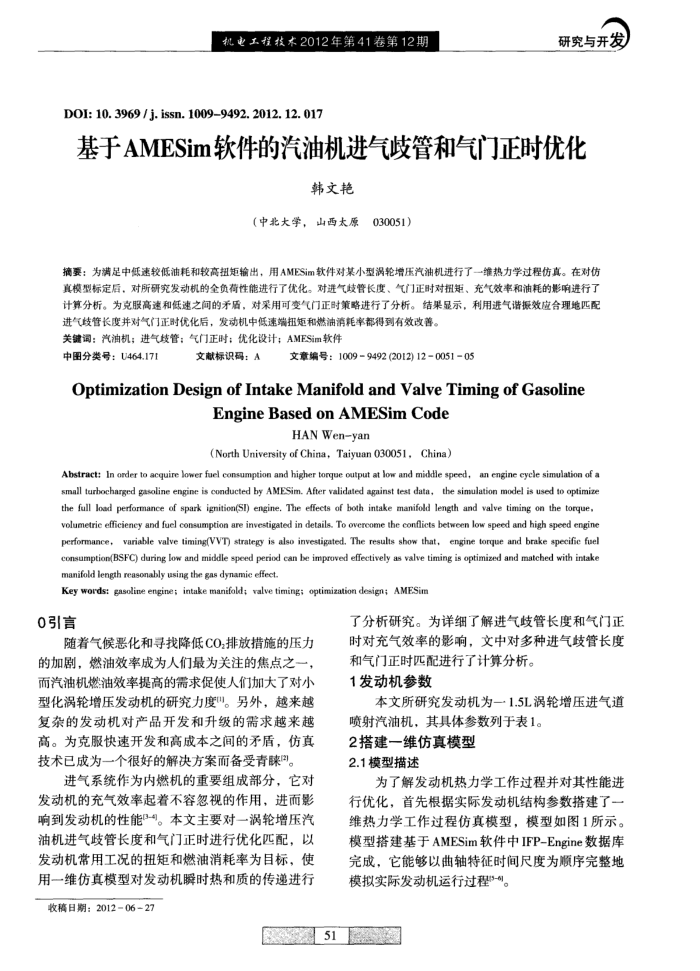基于AMESim软件的汽油机进气歧管和气门正时优化
内容简介
 机电工程技本2012年第41卷第12期
机电工程技本2012年第41卷第12期DOI: 10.3969/j.issn.10099492.2012.12.017
研究与开发
基于AMESim软件的汽油机进气歧管和气门正时优化
韩文艳
(中北大学,山西太原030051)
真模型标定后,对所研究发动机的全负荷性能进行了优化。对进气歧管长度、气门正时对扭矩、充气效率和油耗的影响进行了计算分析。为克服高速和低速之间的矛盾,对采用可变气门正时策略进行了分析。结果显示,利用进气谐振效应合理地匹配
进气歧管长度并对气门正时优化后,发动机中低速端扭矩和燃油消耗率都得到有效改善。关键调:汽油机;进气歧管;气门正时;优化设计;AMESim软件
中图分类号:U464.171
文献标识码:A
文章编号:1009=9492 (2012)120051=05
OptimizationDesignofIntakeManifoldandValveTimingofGasoline
EngineBased on AMESim Code
HAN Wen-yan
(North University of China, Taiyuan 030051, China)
Abstract: In order to acquire lower fuel consumption and higher torque output at low and middle speed, an engine cycle simulation of a small turbocharged gasoline engine is conducted by AMESim. After validated against test data, the simulation model is used to optimize the full load performance of spark ignition(Sl) engine, The effeets of both intake manifold length and valve timing on the torque, volumetric efficiency and fuel consumption are investigated in details. To overeome the conflicts between low speed and high speed enginc performance, variable valve timing(VVT) strategy is also investigated, The results show that, engine torque and brake specifie fuel consumption(BSFC) during low and middle speed period can be improved effectively as valve timing is optimized and matched with intake manifold length reasonably using the gas dynamic effect.
Key words: gasoline engine; intake manifold; ralve timing; optimization design; AMESim
0引言
随着气候恶化和导找降低CO,排放措施的压力的加剧,燃油效率成为人们最为关注的焦点之一,而汽油机燃油效率提高的需求促使人们加大了对小型化涡轮增压发动机的研究力度"。另外,越来越复杂的发动机对产品开发和升级的需求越来越高。为克服快速开发和高成本之间的矛盾,仿真技术已成为一个很好的解决方案而备受青睐3)。
进气系统作为内燃机的重要组成部分,它对发动机的充气效率起着不容忽视的作用,进而影响到发动机的性能(3-4)。本文主要对一涡轮增压汽油机进气歧管长度和气门正时进行优化匹配,以发动机常用工况的扭矩和燃油消耗率为目标,使用一维仿真模型对发动机瞬时热和质的传递进行
收稿日期:201206-27
了分析研究。为详细了解进气歧管长度和气门正时对充气效率的影响,文中对多种进气歧管长度
和气门正时匹配进行了计算分析。 1发动机参数
本文所研究发动机为一1.5L涡轮增压进气道喷射汽油机,其具体参数列于表1。
2搭建一维仿真模型 2.1模型描述
为了解发动机热力学工作过程并对其性能进
行优化,首先根据实际发动机结构参数搭建了。维热力学工作过程仿真模型,模型如图1所示。模型搭建基于AMESim软件中IFP-Engine数据库完成,它能够以曲轴特征时间尺度为顺序完整地模拟实际发动机运行过程"-。
51